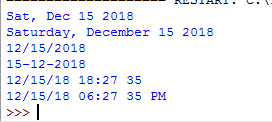

- PYTHON CONVERT STRING TO DATETIME WITH T AND Z HOW TO
- PYTHON CONVERT STRING TO DATETIME WITH T AND Z CODE
PYTHON CONVERT STRING TO DATETIME WITH T AND Z HOW TO
Example – how to convert a string to a date

Now that we understand that, let’s go over one more example that is more complex than the above. For example if we wish to get the year only, we can do that by typing date.year and it will print out just the year. We can decide to retrieve any attributes we want from it. When we print it after that, it will look like this. It requires two parameters: the date string and the format. The method datetime.strptime is the parser that will help us convert the date_string we passed into it as a date. If everything is done correctly, the format should be "%Y/% m/%d."
PYTHON CONVERT STRING TO DATETIME WITH T AND Z CODE
Then we have another forward slash, and finally the day, for which the format code is %d.Īs a result, we must include the forward slash symbol in the format variable in the same way that it appears in the string. Then we have a forward slash followed the month, for which the format code is %m. The first element in the string represents a year, for which the format code is %Y. In this case, the string is in the format "9". We must be aware of the format ahead of time, that is before we pass it to the parser. The format variable declares the format of the date string to be passed to the parser (the function that will help us convert the date).

Let's go over the above code again to make sure we understand what's going on. We can do that by typing the following: from datetime import datetimeįormat = %Y/%m/%d #specifify the format of the date_string.ĭate = datetime.strptime(date_string, format) We need to import the datetime library in Python to be able to achieve this. First, we'll convert the string "9" to the date. Let's look at some examples of string-to-date conversions. For example the %Y code requires 4 numbers to be passed as the year and its range is 0001 – 9999 (so 09, for example, wouldn't work – you need 2009). The element in the string must not exceed the range of the format code.
 The element in the string to be parsed as the year, month, or day must be of the same length as the format code. Firstly, each element in the string must be separated from the others either by a space, letter, or symbol such as / &, % # - and so on. In order to convert a string to a date, it must satisfy the following conditions. Note that the first thing to consider whenever converting a string to date is to make sure that the string is in the right format. How to Convert a String to a DateTime Object We'll stop here for date format codes, but there are many more in the Python documentation. %S - This is used to represents the seconds in a minute and ranges from 00 to 59 as well. %M - This is used to represents minutes in an hour and ranges from 00 to 59. %I - This is used to represent the hours of the day in a 12 hour format and ranges from 01 to 12. %H - This is used to represent the hours of the day in a 24-hour format and ranges from 00 to 23. %d - This is used to represent the days of the month and ranges from 01 to 31. %m - This is used to represent the month of a year and it ranges from 01 to 12. %Y - This is used to represent the Year and it ranges from 0001 to 9999. We will look at some of the most common formatting codes you'll work with anytime you want to convert string to date. These prerequisites will be useful whenever you need to convert a string to a date. DateTime Format Codesīefore we learn how to convert strings to dates, you should understand the formatting codes of datetime objects in Python. This tutorial will teach you how to convert a string to a datetime object in Python. And then you can extract any underlying attributes you want to get from it. The solution to this problem is to parse (or convert) the string object into a datetime object so Python can recognized it as a date. But in this form, you can't access the date's properties like the year, month, and so on. For example, from datetime import datetimeĭatetime_obj = datetime.When you get dates from raw data, they're typically in the form of string objects. To handle this kind of scenario, either pass the correct format or use the try/except. Both the datetime string and format are not compatible, so it raised a ValueError. Here we the string contains the date and time information in format’ MM/DD/YY HH:MM:SS’, but we passed the format string as ‘%d-%m-%Y %H:%M:%S’. Output: ValueError: time data ' 11:12:13' does not match format '%d-%m-%Y %H:%M:%S' For example, from datetime import datetimeĭatetime_obj = datetime.strptime(datetime_str, '%d-%m-%Y %H:%M:%S') If the datetime string and the format string passed in strptime() function are not compatible, then it can cause a ValueError. Python - Access Nth item in List Of TuplesĬonvert string to datetime and handle ValueError Python - Check if a value is in Dictionary Python - Returning Multiple Values in Function
The element in the string to be parsed as the year, month, or day must be of the same length as the format code. Firstly, each element in the string must be separated from the others either by a space, letter, or symbol such as / &, % # - and so on. In order to convert a string to a date, it must satisfy the following conditions. Note that the first thing to consider whenever converting a string to date is to make sure that the string is in the right format. How to Convert a String to a DateTime Object We'll stop here for date format codes, but there are many more in the Python documentation. %S - This is used to represents the seconds in a minute and ranges from 00 to 59 as well. %M - This is used to represents minutes in an hour and ranges from 00 to 59. %I - This is used to represent the hours of the day in a 12 hour format and ranges from 01 to 12. %H - This is used to represent the hours of the day in a 24-hour format and ranges from 00 to 23. %d - This is used to represent the days of the month and ranges from 01 to 31. %m - This is used to represent the month of a year and it ranges from 01 to 12. %Y - This is used to represent the Year and it ranges from 0001 to 9999. We will look at some of the most common formatting codes you'll work with anytime you want to convert string to date. These prerequisites will be useful whenever you need to convert a string to a date. DateTime Format Codesīefore we learn how to convert strings to dates, you should understand the formatting codes of datetime objects in Python. This tutorial will teach you how to convert a string to a datetime object in Python. And then you can extract any underlying attributes you want to get from it. The solution to this problem is to parse (or convert) the string object into a datetime object so Python can recognized it as a date. But in this form, you can't access the date's properties like the year, month, and so on. For example, from datetime import datetimeĭatetime_obj = datetime.When you get dates from raw data, they're typically in the form of string objects. To handle this kind of scenario, either pass the correct format or use the try/except. Both the datetime string and format are not compatible, so it raised a ValueError. Here we the string contains the date and time information in format’ MM/DD/YY HH:MM:SS’, but we passed the format string as ‘%d-%m-%Y %H:%M:%S’. Output: ValueError: time data ' 11:12:13' does not match format '%d-%m-%Y %H:%M:%S' For example, from datetime import datetimeĭatetime_obj = datetime.strptime(datetime_str, '%d-%m-%Y %H:%M:%S') If the datetime string and the format string passed in strptime() function are not compatible, then it can cause a ValueError. Python - Access Nth item in List Of TuplesĬonvert string to datetime and handle ValueError Python - Check if a value is in Dictionary Python - Returning Multiple Values in Function








 0 kommentar(er)
0 kommentar(er)
